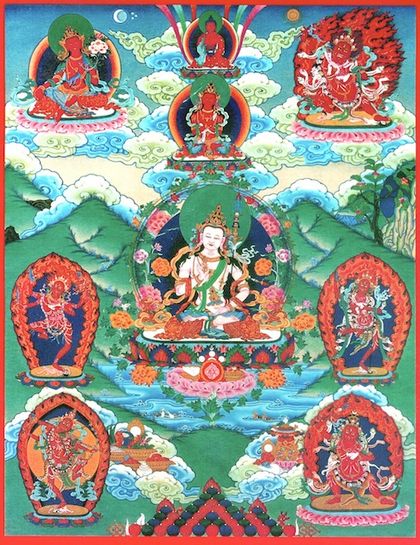Wangdü: Difference between revisions
No edit summary |
No edit summary |
||
| Line 1: | Line 1: | ||
[[Image:Wangdu.jpg|420px|thumb| | [[Image:Wangdu.jpg|420px|thumb|Nine Yidams thangka of Khenpo Jigphun<ref> Khenpo Sodargye explains that “this thangka was commissioned by Khenpo Jigme Phuntsok, who asked a famous artist to paint it. The thangka is called “The Nine Yidams”. Although different masters have different views on the Nine Yidams (as shown in Metrul Tenzin Gyatso’s commentary), this ritual of the Nine Yidams is a terma of Padmasambhava, revealed by Tertön Lerab Lingpa, Khenpo Jigme Phuntsok’s previous incarnation. The Wangdu prayer was composed by Mipham Rinpoche. The order of the Wangdu prayer does not correspond completely to the Nine Yidam practice, but enough for this thangka to be relevant. The main objects of supplication in the Wangdu prayer are these nine yidams, each surrounded by an assembly of countless deities”. </ref>]] | ||
'''Wangdü''' (Tib. དབང་སྡུད་, [[Wyl.]] ''dbang sdud'') is the common abbreviated title of the prayer by [[Mipham Rinpoche]] called ''The Great Cloud of Blessings: The Prayer which Magnetizes All that Appears and Exists'' (སྣང་སྲིད་དབང་དུ་སྡུད་པའི་གསོལ་འདེབས་བྱིན་རླབས་སྤྲིན་ཆེན་, ''snang srid dbang du sdud pa'i gsol 'debs byin rlabs sprin chen''). It was written in 1879. | '''Wangdü''' (Tib. དབང་སྡུད་, [[Wyl.]] ''dbang sdud'') is the common abbreviated title of the prayer by [[Mipham Rinpoche]] called ''The Great Cloud of Blessings: The Prayer which Magnetizes All that Appears and Exists'' (སྣང་སྲིད་དབང་དུ་སྡུད་པའི་གསོལ་འདེབས་བྱིན་རླབས་སྤྲིན་ཆེན་, ''snang srid dbang du sdud pa'i gsol 'debs byin rlabs sprin chen''). It was written in 1879. | ||
| Line 18: | Line 18: | ||
==Commentary== | ==Commentary== | ||
* | *oral commentary by [[Khenpo Namdrol]]. | ||
*long commentary by Metrul Tenzin Gyatso, a student of [[Khenpo Jikmé Phuntsok]]. | *long commentary by Metrul Tenzin Gyatso, a student of [[Khenpo Jikmé Phuntsok]]. | ||
==Teachings on Wangdü== | ==Teachings on Wangdü== | ||
*[[Sogyal Rinpoche]], Lerab Ling, 17 August 1996, 12:00 | |||
*[[Alak Zenkar Rinpoche]], [[Lerab Ling]], 17 June 2009 | *[[Alak Zenkar Rinpoche]], [[Lerab Ling]], 17 June 2009 | ||
* | *Sogyal Rinpoche, [[Lerab Ling]], 1-2 June 2009 | ||
*Sogyal Rinpoche, Lerab Ling, | *Orgyen Tobgyal Rinpoche, Lerab Ling, 7 November 2013 | ||
*Sogyal Rinpoche, Lerab Ling, 8 November 2013 | |||
==External Links== | ==External Links== | ||
*{{LH|tibetan-masters/mipham/great-cloud-blessings|''Wang Dü: ‘The Great Cloud of Blessings’—The Prayer which Magnetizes All that Appears and All that Exists'' by Mipham Rinpoche}} | *{{LH|tibetan-masters/mipham/great-cloud-blessings|''Wang Dü: ‘The Great Cloud of Blessings’—The Prayer which Magnetizes All that Appears and All that Exists'' by Mipham Rinpoche}} | ||
*[http://www.khenposodargye.org/teachings/foundation/commentary-on-the-prayer-which-magnetizes-all-that-appears-and-exists/ Oral commentary on Wang Dü by Khenpo Sodargye] | *[http://www.khenposodargye.org/teachings/foundation/commentary-on-the-prayer-which-magnetizes-all-that-appears-and-exists/ Oral commentary on Wang Dü by Khenpo Sodargye] | ||
==References == | |||
<small><references></small> | |||
[[Category:Prayers and Practices]] | [[Category:Prayers and Practices]] | ||
Revision as of 13:26, 6 January 2017

Wangdü (Tib. དབང་སྡུད་, Wyl. dbang sdud) is the common abbreviated title of the prayer by Mipham Rinpoche called The Great Cloud of Blessings: The Prayer which Magnetizes All that Appears and Exists (སྣང་སྲིད་དབང་དུ་སྡུད་པའི་གསོལ་འདེབས་བྱིན་རླབས་སྤྲིན་ཆེན་, snang srid dbang du sdud pa'i gsol 'debs byin rlabs sprin chen). It was written in 1879.
Prayer Flag
The prayer flag contains both images and prayers. In the prayer flag flown at Rigpa centres the images are of the deities mentioned in the prayer and are based on a print of a thangka given to Sogyal Rinpoche by Khenpo Jikme Phuntsok (Khenpo Jigphun). Khenpo Jigphun flew many Wangdü prayer flags around his monastery. Previously this prayer flag was not widely distributed and was considered secret or, perhaps, personal.
- The central deity is Pema Gyalpo portrayed in Sambhogakaya form.
- Above are Vajradharma (Tib. Dorje Chö) and, at the top, Amitabha.
- Avalokiteshvara, as Padmapani, and Hayagriva are top left and right.
- The two dakinis, Guhyajñana and Vajravarahi, are on either side of Pema Gyalpo.
- Kurukulla and Döpé Gyalpo are in the bottom left and right corners.
Normally mantras and prayers are the main feature of prayer flags, rather than images, so it is the prayer that is the main thing, as it says in the text.
Recently this image has been printed in the Rigpa Calendar, following advice that this would be beneficial.
Usually it is printed on red cloth.
Commentary
- oral commentary by Khenpo Namdrol.
- long commentary by Metrul Tenzin Gyatso, a student of Khenpo Jikmé Phuntsok.
Teachings on Wangdü
- Sogyal Rinpoche, Lerab Ling, 17 August 1996, 12:00
- Alak Zenkar Rinpoche, Lerab Ling, 17 June 2009
- Sogyal Rinpoche, Lerab Ling, 1-2 June 2009
- Orgyen Tobgyal Rinpoche, Lerab Ling, 7 November 2013
- Sogyal Rinpoche, Lerab Ling, 8 November 2013
External Links
 Wang Dü: ‘The Great Cloud of Blessings’—The Prayer which Magnetizes All that Appears and All that Exists by Mipham Rinpoche
Wang Dü: ‘The Great Cloud of Blessings’—The Prayer which Magnetizes All that Appears and All that Exists by Mipham Rinpoche- Oral commentary on Wang Dü by Khenpo Sodargye
References
<references>
- ↑ Khenpo Sodargye explains that “this thangka was commissioned by Khenpo Jigme Phuntsok, who asked a famous artist to paint it. The thangka is called “The Nine Yidams”. Although different masters have different views on the Nine Yidams (as shown in Metrul Tenzin Gyatso’s commentary), this ritual of the Nine Yidams is a terma of Padmasambhava, revealed by Tertön Lerab Lingpa, Khenpo Jigme Phuntsok’s previous incarnation. The Wangdu prayer was composed by Mipham Rinpoche. The order of the Wangdu prayer does not correspond completely to the Nine Yidam practice, but enough for this thangka to be relevant. The main objects of supplication in the Wangdu prayer are these nine yidams, each surrounded by an assembly of countless deities”.